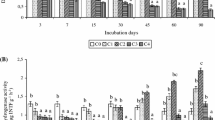Abstract
Laboratory tests were conducted to determine the effects of five pyrethroid insecticides—permethrin (FMC 33297) [3-phenoxybenzyl (±)-3-(2,2-dichlorovinyl)-2,2-dimethylcyclopropanecarboxylate]; FMC 45498 [(S)-α-cyano-3-phenoxybenzyl-(R)-cis-2-(2,2-dibromovinyl)-3,3-dimethylcyclopropanecarboxylate]; Shell WL 41706 [(±)-α-cyano-3-phenoxybenzyl 2,2,3,3-tetramethylcyclopropane-carboxylate]; Shell WL 43467 [(±)-α-cyano-3-phenoxy benzyl (±)-cis,trans-2-(2,2-dichlorovinyl)-3,3-dimethylcyclopropanecarboxylate]; and Shell WL 43775 [(±)-α-cyano-3-phenoxybenzyl (±)-2-(4-chlorophenyl)-3-methylbutyrate]—at 0.5 and 5μg/g on microbial populations and activities in a sandy loam. The insecticides had antimicrobial activity in early stages of incubation. The populations recovered after 2 to 4 weeks and stimulatory effects on populations were also observed in later stages. No inhibition of acetylene (C2H2) reduction was evident with any of the insecticides. However, WL 43467 at both concentrations and permethrin and WL 41706 at 5 μg/g increased nitrification after 4 weeks. Soil microbial respiration, as indicated by oxygen consumption, increased with increasing concentration of insecticides, suggesting the possibility of microbial degradation of the insecticides. Dehydrogenase activity showed that none of the insecticides inhibited formazan (2,3,5-triphenyltetrazolium formazan) formation, whereas urease activity was stimulated in most cases. The studies indicated that some of the pyrethroid insecticides may exert transient effects on populations and activities of the microflora in a sandy loam, but these were short-lived and minor in nature.
Similar content being viewed by others
References
American Public Health Association, American Water Works Association, & Federation of Sewage and Industrial Wastes Associations: Standard Methods for the Examination of Water and Sewage, 10th Ed. American Public Health Association, New York (1955)
Bartha, R., R. P. Lanzilotta, and D. Pramer: Stability and effects of some pesticides in soil. Appl. Microbiol.15, 67–75 (1967)
Birch, H. F.: Nitrification in soils after different periods of drying. Plant Soil12, 81–96 (1960)
Bremner, J. M., and D. R. Keeney: Determination and isotope-ratio analysis of different forms of nitrogen in soils. 3. Exchangeable ammonium, nitrate, and nitrite by extraction-distillation methods. Soil Sci. Soc. Am. Proc.30, 577–582 (1966)
Brown, A. W. A.: Ecology of Pesticides. John Wiley and Sons, New York (1978)
Bunt, J. S., and A. D. Rovira: The effect of temperature and heat treatment on soil metabolism. J. Soil Sci.6, 129–136 (1955)
Casida, L. E., D. A. Klein, and T. Santoro: Soil dehydrogenase activity. Soil Sci.98, 371–376 (1964)
Elliot, M.: Future use of natural and synthetic pyrethroids. In R. L. Metcalf and J. J. McKelvey, Jr. (eds.): The Future for Insecticides. Needs and Prospects. John Wiley and Sons, New York (1976)
Harper, H. J.: The accurate determination of nitrates in soils. Ind. Eng. Chem.16, 180–183 (1924)
Harris, C. R., and S. A. Turnbull: Laboratory studies on the contact toxicity and activity in soil of four pyrethroid insecticides. Can. Entomol.110, 285–288 (1978)
Martin, J. P.: Use of acid, rose bengal and streptomycin in the plate method for estimating soil fungi. Soil Sci.69, 215–233 (1950)
Strider, D. L.: Activity of pyrethroid insecticides against powdery mildew fungi. Plant Dis. Rep.60, 512–514 (1976)
Tu, C. M.: Effect of four organophosphorus insecticides on microbial activities in soil. Appl. Microbiol.19, 479–484 (1970)
Tu, C. M.: Influence of physical treatments on acetylene reduction (nitrogen fixation) in soils. Comm. Soil Sci. Plant Analy.8, 605–613 (1977)
Tu, C. M.: Effect of pesticides on acetylene reduction and microorganisms in a sandy loam. Soil Biol. Biochem.10, 451–456 (1978)
Tu, C. M., and J. R. W. Miles: Interaction between insecticides and soil microbes. Residue Rev.64, 17–65 (1976)
Waksman, S. A., and E. B. Fred: A tentative outline of the plate method for determining the number of microorganisms in the soil. Soil Sci.14, 27–28 (1922)
Walkley, A., and J. A. Black: An examination of Degtjareff method for determining soil organic matter and a proposed modification of the chromic acid titration method. Soil Sci.37, 29–38 (1934)
Author information
Authors and Affiliations
Rights and permissions
About this article
Cite this article
Tu, C.M. Influence of five pyrethroid insecticides on microbial populations and activities in soil. Microb Ecol 5, 321–327 (1980). https://doi.org/10.1007/BF02020339
Issue Date:
DOI: https://doi.org/10.1007/BF02020339




